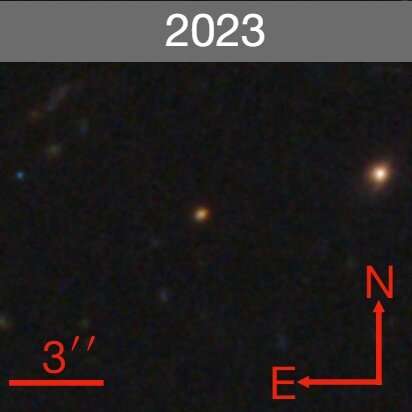Full color image of SN 2023adsy. Credit: Pierel et al., 2024.
Using the James Webb Space Telescope (JWST), astronomers from the Space Telescope Science Institute (STScI) have discovered a new supernova. Designated SN 2023adsy, the newfound stellar explosion is the most distant Type Ia supernova so far detected. The finding was detailed in a research paper published June 7 on the pre-print server arXiv.
Supernovae (SNe) are powerful and luminous stellar explosions. They are important for the scientific community as they offer essential clues into the evolution of stars and galaxies. In general, SNe are divided into two groups based on their atomic spectra: Type I (no hydrogen in their spectra) and Type II (showcasing hydrogen spectral lines).
Type Ia supernovae (SN Ia) are found in binary systems in which one of the stars is a white dwarf. Stellar explosions of this type are important for the scientific community, as they offer essential clues into the evolution of stars and galaxies.
SN 2023adsy was initially identified in 2023 as a transient object in the galaxy JADES-GS+53.13485−27.82088, at a redshift of 2.9. Follow-up observations of SN 2023adsy suggested that it may be a supernova of Type Ia.
Now, a new study conducted by a team of astronomers led by STScI's Justin R. Pierel confirms the previous assumptions.
"We have presented JWST observations of a SN (SN 2023adsy) with a spectroscopic redshift of z =2.903 ± 0.007, which we classify using both the spectrum and light curve information as the most distant SN Ia yet discovered," the researchers wrote in the paper.
The obtained images show that SN 2023adsy is very red, which may be due to significant dust attenuation from the host galaxy JADES-GS+53.13485−27.82088. However, this galaxy has a relatively low-mass, low-metallicity and low-extinction, hence it indicates that SN 2023adsy could be intrinsically red.
The study found that SN 2023adsy showcases strong ionized calcium spectral lines (Ca II) in its spectrum, with a measured velocity of about 19,000 km/s. This is a relatively high velocity compared to the general population of known SNe Ia.
The astronomers underline that while these peculiarities of SN 2023adsy are also observable in some calcium-rich Type Ia supernovae, the newfound SN is intrinsically brighter than the overall population of low-redshift calcium-rich SNe Ia.
Summing up the results, the authors of the paper note that more observations of Type Ia supernovae are required in order to find out whether SN 2023adsy, due to its peculiarities, is an outlier among the population of SNe Ia, or the distribution of properties of these supernovae varies significantly with redshift due to changes in progenitors or their environment.
"A larger sample of distant SNe Ia is required to determine if SN Ia population characteristics at high-z truly diverge from their low-z counterparts, and to confirm that standardized luminosities nevertheless remain constant with redshift," the scientists conclude.
More information: J. D. R. Pierel et al, Discovery of An Apparent Red, High-Velocity Type Ia Supernova at z = 2.9 with JWST, arXiv (2024). DOI: 10.48550/arxiv.2406.05089
Journal information: arXiv
© 2024 Science X Network
























